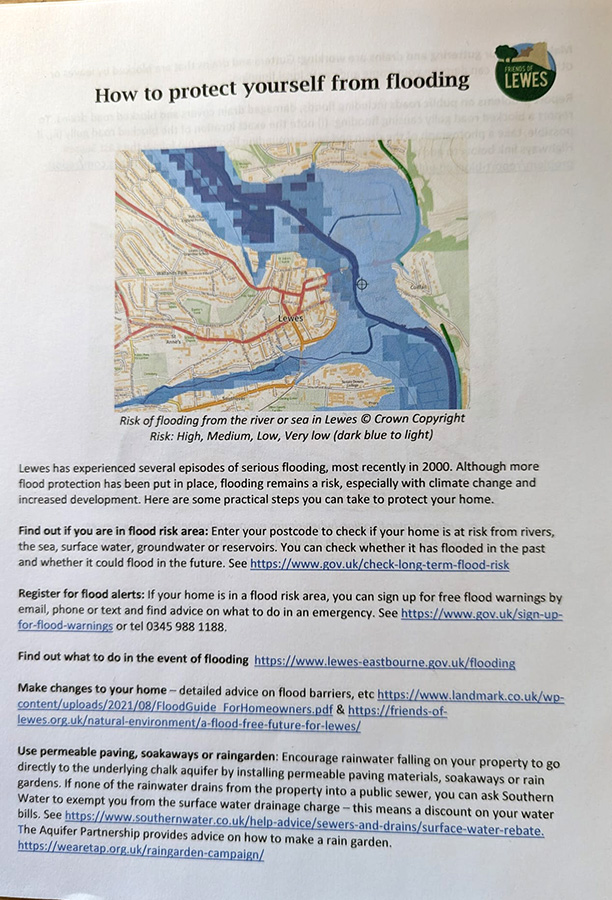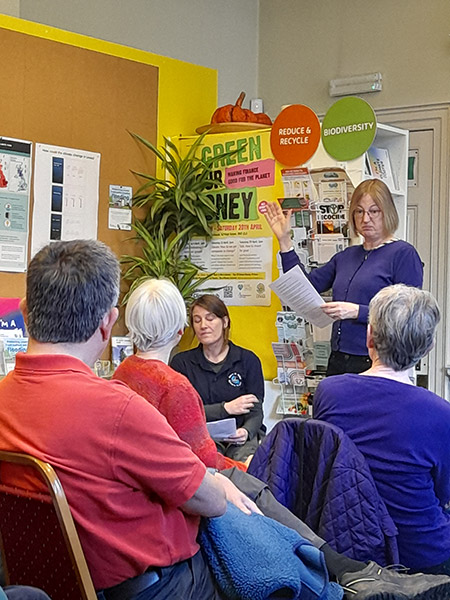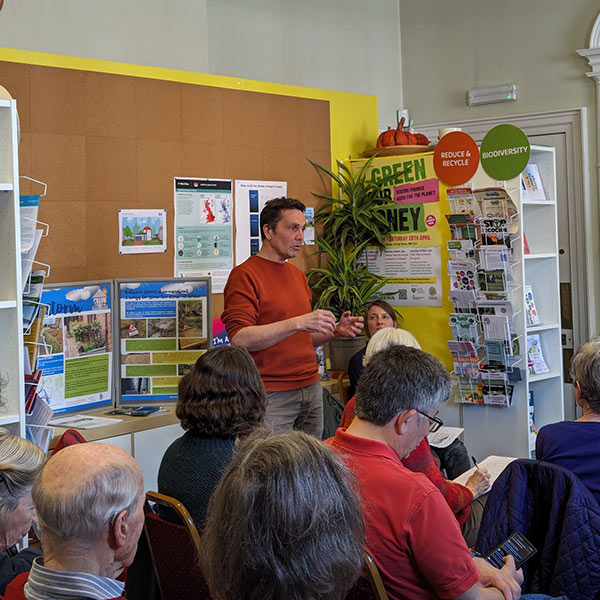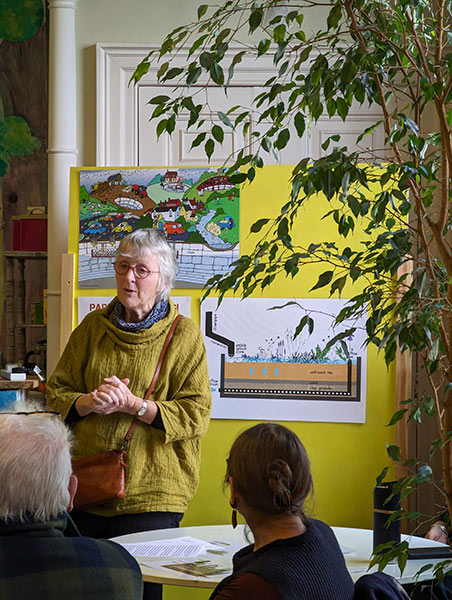
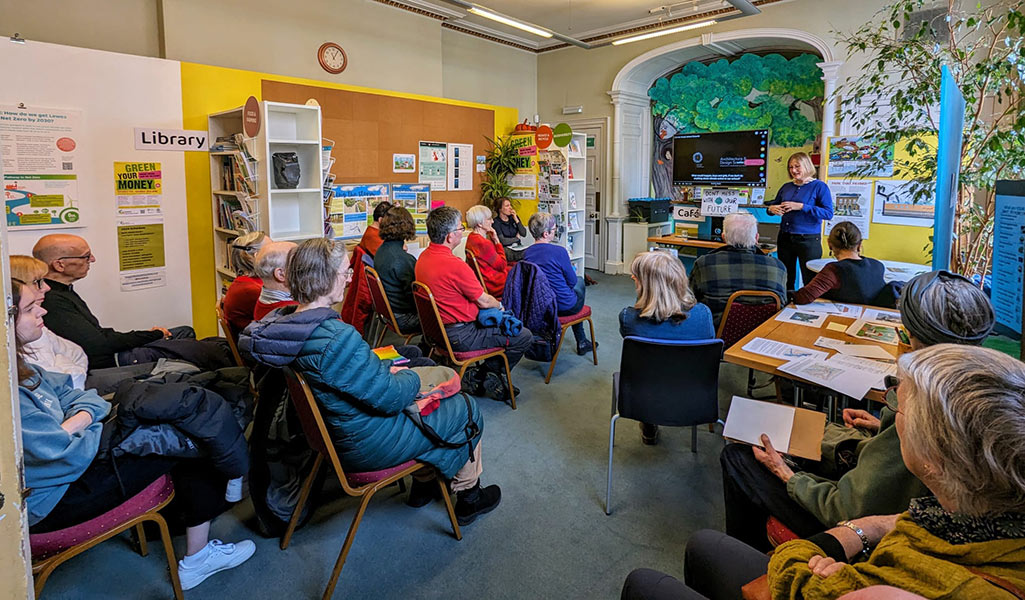
15 things we learned about surface water flooding in Lewes
At a Saturday talk in April, experts and local group representatives explored the risk of surface water flooding in Lewes and how it can be mitigated. Ann Link looks at 15 things we learned.
In April, Lewes Climate Hub and Friends of Lewes co-hosted what we hope will be the first of many events addressing how to make our community more resilient against the impacts of climate change.
‘Protecting Lewes from Surface Water Flooding’ brought together Diana Wilkins, Bronagh Liddicoat and John Gower (ex-Environment Agency) from Friends of Lewes along with Rachel Paget from Ouse and Adur Rivers Trust, and Matthew Bird of Love Our Ouse (and former cabinet member for sustainability at Lewes District Council).
Together they explained the different reasons for Lewes’ vulnerability to surface flooding and what steps can be taken to manage it. Here are a few of the things we learned.
- Lewes is already prone to flooding from its tidal river, the Ouse. Many people were affected by the flood in 2000 and there have been floods every few decades back into history.
- Climate change is increasing the risks. There is more rain in winter and storms are more intense. We can find out the local predicted and actual changes in climate from the Met Office. Summers will get hotter and drier; winters will be wetter than in the past. But crucially, the wettest days of both winter and summer WILL get wetter, depending on the extent of global heating. So we need to prepare: we are not coping with present-day flooding as it is, and it’s set to get worse.
- Flood defences in and around Lewes have improved since 2000, including slowing the flow from the large (250 square mile) catchment area of the Ouse. Measures including leaky dams and scrapes in the ground have made a difference.
- Surface water flooding is caused by run-off from roads and roofs and other hard surfaces. Other flooding can be caused by groundwater rising, or when rivers overflow.
- A rain garden planter is a large container designed to slow the flow of torrential rain from a roof into drains and soakaways. The planter doesn’t get boggy because the water sinks and leaks out fairly rapidly. But the point is to absorb an intense pulse of water during a storm, which can cause local flooding affecting roads and houses. For more information and how to make a rain garden planter, visit The Aquifer Partnership here.
- Residents in the city of Portland in Oregon State in the US have installed 56,000 rain garden planters, over a couple of decades, to manage the effects of intense rainfall. This was relatively cheap and has had a huge impact.
- Sewage on the Nevill Estate in Lewes is carried in a combination drain for both sewage and surface water. This is no longer adequate and the increasing sewage flows and rainfall intensity can result in sewage overflows on Nevill Green and Nevill Road. Sometimes tomato plants can be seen growing in the gutters. The problems on the Nevill Estate have been looked at by East Sussex Highways and Southern Water. Some improvements have been made – but with rainfall getting more intense, work is not keeping up.
- Residents of the Nevill estate are being offered rain garden planters by a partnership of Lewes District Council, Friends of Lewes and Ouse and Adur Rivers Trust, to help mitigate flooding on Nevill Road. In some cases, the water from the planters can simply soak into the chalk beneath people’s gardens, or it can be redirected into the drain, but more slowly. This should help to reduce flooding problems, and there are plans for further work.
- No planning permission is needed for a driveway IF you use a permeable material OR divert the water to a lawn or border to drain away naturally, or if you are paving less than five square metres. Permeability can be improved by laying down gravel, grass grids, or strip paving, as well as permeable block paving or permeable resin.
- Gutters on older houses may not be big enough for torrential rain. Typically, these have a diameter of 4 inches. If our gutters (or our neighbour’s) are blocked we may suffer with leaks. The good news is that blockages can be remedied quickly, as has been done at the Town Hall.
- School grounds across the UK add up to an area of hard surfaces equivalent to a new national park. Wallands School is a local example of action to change this. With the help of developers’ levy funding of £150,000, the playground at Wallands School has a permeable surface, with shelters and flowerbeds, and rain garden planters are at the foot of every downpipe, slowing the water flow from the school’s roofs. Children understand the principles behind these changes and can explain them to their parents.
- Ouse and Adur Rivers Trust put a demonstration planter in every school in the Ouse catchment. Other flood prevention measures have been installed in school grounds.
- In the Cuilfail area of Lewes, residents have funded changes to address flooding. Cuilfail is a private road that rises steeply to the east of Cliffe. Residents have funded changes to the road so that water goes onto verges rather than pouring down into the town below.
- Each month, Friends of Lewes look at planning applications with regard to surface water flooding. However, they have not got the resources to check if the measures have been implemented, and the District Council does not have the capacity to check either.
- A national scheme of flood readiness no longer exists, and local authorities do not have enough money to manage their own local readiness. The Flood and Water Management Act 2010, which aims to reduce the risks from extreme weather, has not been fully implemented. So it’s up to citizens to demand that sustainable drainage in new developments becomes the law, including asking MP candidates at the upcoming General Election where they stand on the issue of flooding.
In short…
There is woefully little co-ordinated action at the national level, or resources at the local level to address the growing risk of surface flooding.
But there are many things we can do at a community and resident level – from installing more rain garden planters outside homes, schools and other buildings, unblocking our gutters and replacing hard paving with permeable options to allow water to soak into the ground rather than inundating our drains yet further.
Resources:
To report a flood – go to https://www.eastsussex.gov.uk/community/emergency-planning/advice/flooding
To take action – Go to https://floodmary.com/ for advice on how to prepare your home, from a homeowner (and flooding survivor) who has been helping others for 20 years.


